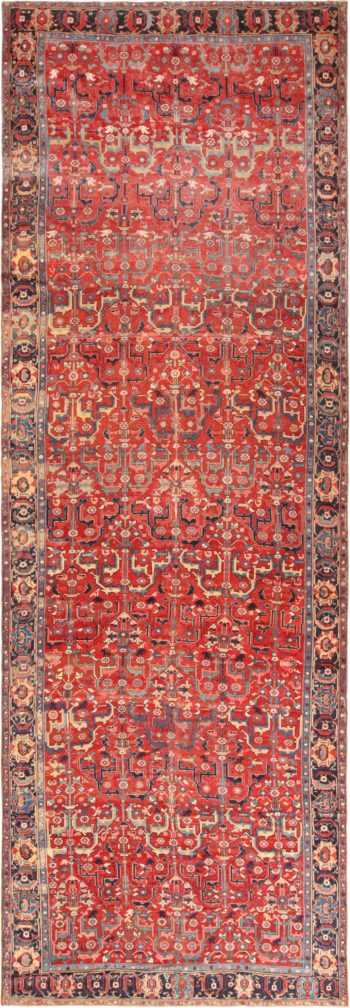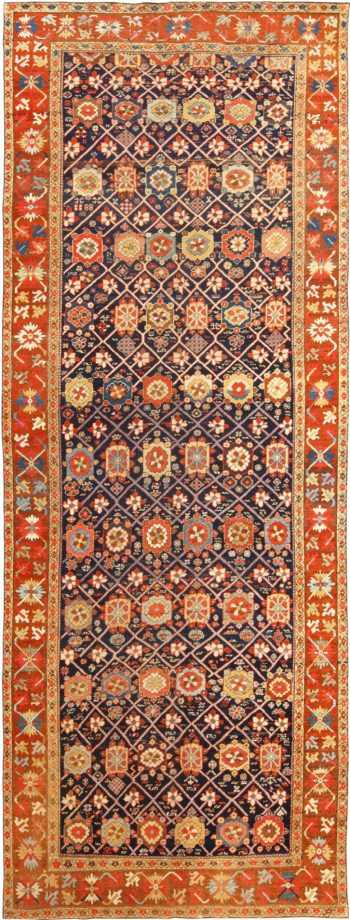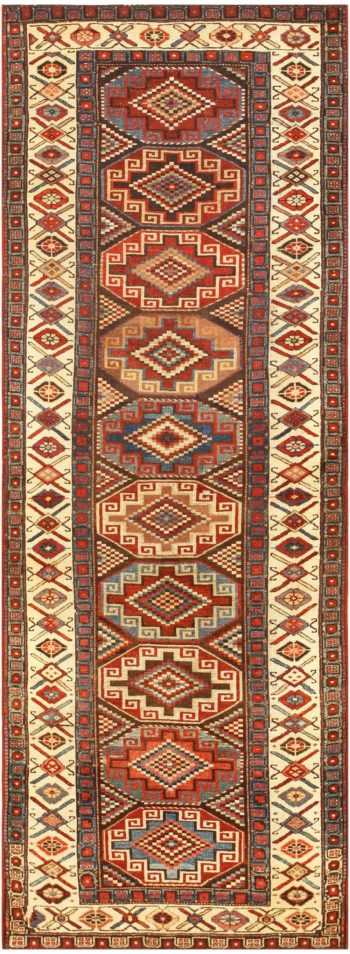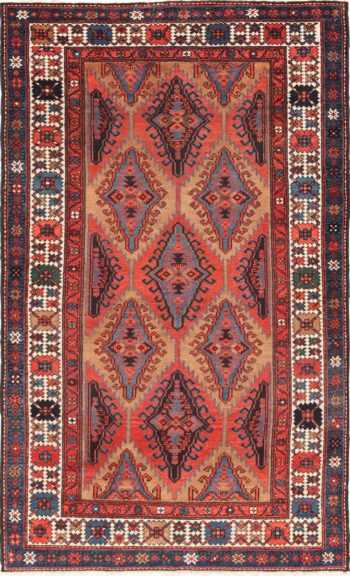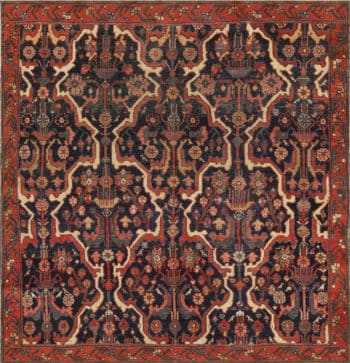North West Antique Persian Rugs
Shop Our Unique Collection Of North West Persian Rugs
View our current selection of antique North West Persian rugs below:
Antique North West Persian Wide Hallway Gallery Rug 71176
$24,000.00Size: 6 ft 9 in x 19 ft 6 in (2.06 m x 5.94 m)Tribal Long Antique Navy Northwest Persian Runner Rug 49586
$18,500.00Size: 3 ft 10 in x 19 ft 5 in (1.17 m x 5.92 m)19th Century Antique Tribal North West Persian Hallway Runner Rug 72107
$16,500.00Size: 2 ft 7 in x 18 ft (0.79 m x 5.49 m)Rustic Antique Tribal Paisley North West Persian Gallery Size Abrash Rug 72150
$24,500.00Size: 5 ft 4 in x 17 ft (1.63 m x 5.18 m)Soft Purple Tribal Antique North West Persian Tribal Abrash Runner Rug 72110
$9,500.00Size: 3 ft 8 in x 14 ft 3 in (1.12 m x 4.34 m)Tribal Jewel Tone Antique Northwest Persian Gallery Rug 49161
$36,000.00Size: 5 ft 5 in x 14 ft (1.65 m x 4.27 m)Antique Tribal Northwest Persian Runner Rug 50669
$7,400.00Size: 3 ft 7 in x 13 ft 5 in (1.09 m x 4.09 m)Antique Tribal Geometric Northwest Persian Hallway Runner Rug 71841
$8,800.00Size: 3 ft 4 in x 13 ft 2 in (1.02 m x 4.01 m)Tribal Antique Northwest Persian Runner Rug 49424
$16,000.00Size: 4 ft 3 in x 13 ft (1.3 m x 3.96 m)Tribal Paisley Antique North West Persian Rug 71139
$19,500.00Size: 6 ft 5 in x 11 ft 8 in (1.96 m x 3.56 m)Rare Collectible Tribal Antique Northwest Persian Runner Rug 70352
Size: 3 ft 3 in x 11 ft 2 in (0.99 m x 3.4 m)Antique Tribal Northwest Persian Runner Rug 49711
$6,400.00Size: 3 ft 4 in x 10 ft 4 in (1.02 m x 3.15 m)Tribal Antique North West Persian Hallway Runner Allover Rug 72112
$6,750.00Size: 3 ft 6 in x 9 ft 8 in (1.07 m x 2.95 m)Tribal Geometric Antique Northwest Persian Jewel Tone Hallway Runner Rug 47536
$8,800.00Size: 3 ft 5 in x 9 ft 3 in (1.04 m x 2.82 m)Small Tribal Geometric Antique Northwest Persian Rug 49641
Size: 4 ft 6 in x 7 ft (1.37 m x 2.13 m)Small Square Shape Antique Tribal Northwest Persian Area Rug 72563
$3,600.00Size: 4 ft 8 in x 4 ft 9 in (1.42 m x 1.45 m)
Learn More About Tribal Antique North West Persian Rugs
North West Persian Rugs – is the area straddling the Caucasus mountains, Caspian sea and borders with South Asiaa. Rugs produced in North West Persia represent a convergence of cultures from the Kazakhs and Khazars to the invading Mughals. The region of N. West Persia includes parts of Iran, Azerbaijan and Armenia. Carpet weavers in N. West Persia were not the most prolific craftspeople but their rare high quality carpets are sought after commodities that regularly sell for record breaking sums. Historic evidence depicting looms and detailed carpet patterns confirms the development of knotted pile carpets and flat woven Kilim rugs during the Timurid dynasty which thrived between 1300 and 1500.
The oldest known carpet in the Northwest Persian style was produced in the city of Tabriz. It depicts a bountiful hunting scene with lush vegetation. This ancient pictorial carpet from Tabriz dates to the 16th century and the rule of the influential Shah Abbas. Before Shah Abbas overthrew the Safavid dynasty, their wealthy leaders funded a renaissance of the Islamic arts that would last more than a century.
Carpets produced in Tabriz during this era were highly pictorial but also featured Islamic calligraphy, detailing folklore and writings from the famous Northwest Persian poets. Geometric patterns and bold colors were introduced to north west Persian carpets through tribal groups and nomads who traveled through the many fertile valleys of the south Caucasus.
During the 17th century, carpet weavers from the port city of Baku, adapted their own style known as Khila Afshan. This style was based on geometric adaptations of the floral patterns produced in Tabriz. Unlike carpets from Tabriz, which used a variety of earth tones and low contrast colors rugs, the Khila Afshan rugs of Baku used brilliant reds blues and bright whites.
According to historic evidence, the Kazakhs split off from Mongol tribes sometime during the 12th or 13th century. By the 15th century the conqueror Babur invaded sub continental India where he established the Mughal empire. The Muslim Mughals, who were an offshoot of the Timurid Dynasty, also influenced carpet design in Northwest Persia.
Carpets from Heriz, in Northwest Persia, contain strikingly similar elements to those used by the Mughal carpet weavers. However, the serrated edges and accentuated coloration found in carpets from Heriz, are unique to Northwest Persia. Under the rule of the Seljuk Empire, the region of Kurdistan became intertwined with Western Persia.
Throughout history, the Kurds have remained true to their heritage by faithfully preserving tribal symbols, dye recipes and weaving techniques. They ignored many of the time saving inventions that many areas had already adopted. Groups like the Kurds, were instrumental in maintaining elements like the classic Persian blue used in carpets from Bidjar and Western Iran.
During the 19th century, the Kazakhs regained influence over carpet designs in Northwest Persia. According to official census documents from 1830, the vast majority of artisan dyers and carpet weavers in Northwest Persia were non native refugees who emigrated from Armenia (which was undergoing social turmoil as Russia conquered parts of that country).
North West Persian carpet designs from the 19th century incorporate geometric elements from Armenian refugees as well as European elements (like all over lattice work seen in rugs from this region).
The demand from foreign markets for the antique Persian rugs, during the 19th century, helped cities in Northwest Persia maintain their carpet making traditions. Major antique rug producing cities like Tabriz, flourished with the influx of European investments.
Up until the first quarter of the 20th century, master weavers and luminaries, like Haji Jalili (of Tabriz) continued to produce elaborate designs that advanced the art of Northwest Persian carpet weaving and made the area’s designs legendary.
These intriguing and highly decorative rugs were produced near the border between Safavid Persia, Turkey and the tribal lands of the Caucasus. The angular, rectilinear designs featured in these rugs visually confirm their geographic origin along the borders of these three regions that posses deeply contrasting styles. The Northwest Persian designation is a vague and sometimes controversial term due to the foggy history and political changes that took place in the region, but the designation is always corroborated by the style, structure and materials of these archaic pieces.
The pile carpets and decorative Kilims produced in Persia’s northernmost province bear striking similarities between some Caucasian rugs and those produced in modern-day Azerbaijan. One common thread between the carpets of the Caucasus and those produced in the western Persian province of Azarbayjan-e-Gharbi and the informal area of Iranian Kurdistan is the presence of multi-ethnic weavers. Elegant Northwest Persian rugs are typically attributed to parts of Iranian Kurdistan and Azarbayjan-e-Gharbi. They feature rectilinear patterns, grand lozenges, dramatic harshang palmettes and large-scale arabesques that bear some similarity to the sophisticated carpets produced in Sultanabad and the cities along Persia’s western frontier.
Political instability and continually changing borders pushed ethnic weavers between Persia, Turkey and the Caucasus. Centuries after Northwest Persian rugs were created, their style, structure and physical attributes reveal more about the area than many history books can. The rugs of North west Persia are the pure forerunners of the elegant and extremely popular rugs produced in Heriz, Serab, Ahar and other northern regions.
What makes the antique North West Persian rugs so desirable?
Antique North West Persian rugs are highly desirable for several reasons, combining elements of artistry, craftsmanship, history, and cultural significance.
Here are some factors that contribute to the desirability of area rugs from North West Persia:
- Artistic and Intricate Designs: North West Persian rugs are known for their intricate and captivating designs. These designs often incorporate geometric patterns, floral motifs, and rich color palettes, creating visually stunning and harmonious compositions that are appreciated as works of art.
- Craftsmanship and Skill: The creation of antique Persian rugs involves exceptional craftsmanship and skill. Skilled artisans spend months, or even years, hand-weaving each rug using traditional techniques passed down through generations. The level of detail, precision, and dedication to producing high-quality rugs is a testament to the artistry of these pieces.
- Historical Significance: Antique rugs from the North West Persian region hold historical value. They provide a glimpse into the cultural, artistic, and socio-economic context of the time when they were created. These rugs often reflect the aesthetic preferences, customs, and influences of the regions where they originated.
- Unique and Limited Availability: Antique rugs are finite in number, and as time goes on, their availability decreases due to natural wear, tear, and deterioration. As a result, owning an antique rug becomes a way to connect with history and own a piece of art that is both rare and unique.
- Cultural Heritage: Persian rugs are an integral part of Persian culture and heritage. They have been woven for centuries and have played a significant role in the lives of people in the region. Owning an antique North West Persian rug allows collectors to appreciate and preserve this cultural heritage.
- Investment Value: High-quality antique rugs, especially those with well-documented provenance and exceptional craftsmanship, can appreciate in value over time. Many collectors and enthusiasts consider them not only as decorative items but also as potential investments.
- Versatile Decorative Element: Antique rugs can add a touch of elegance and sophistication to interior spaces. Their intricate designs and rich colors can complement various design styles, from traditional to contemporary, making them versatile decorative assets.
- Symbolism and Meaning: Persian rugs often carry symbolism and meaning within their designs. Specific patterns, motifs, and colors can represent different aspects of life, nature, and spirituality, adding depth and significance to the rug’s appeal.
- Collector’s Passion: Collecting antique rugs can be a passion for many individuals who appreciate the beauty, history, and cultural significance of these pieces. The thrill of discovering unique rugs and learning about their origins can drive collectors’ desire to acquire and preserve them.
In summary, the desirability of antique North West Persian rugs stems from a combination of their artistic beauty, historical value, cultural significance, craftsmanship, and the passion of collectors and enthusiasts who value these exquisite creations.

